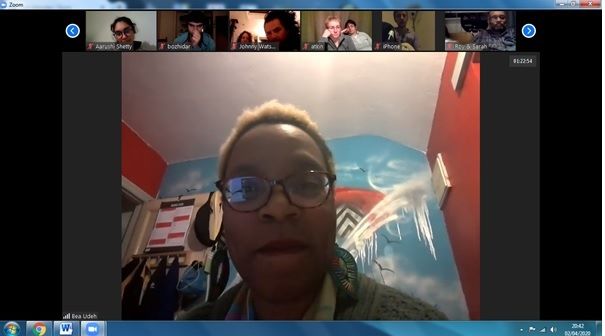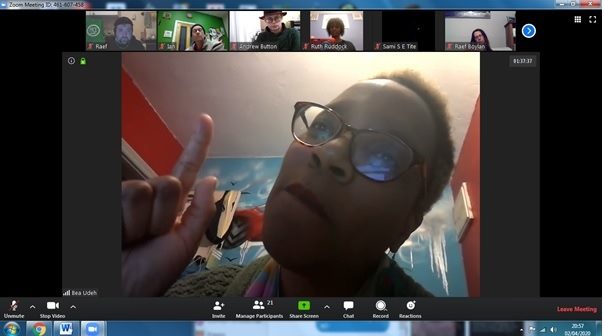INTERVIEW: FIRE & DUST MEETS BEA UDEH
DREAM-DROPS AND DOODLES ON OKRA BY BEA UDEH
BIG WHITE SHED
ISBN: 978-1916403536
£11.99/56 pages

Daughter
(In response to the 1976 Highlife song Sweet Mother
by Prince Nico Mbarga and Rocafil Jazz)
____________________________In memory of our girls in Chibok
I am the eldest daughter
of the eldest daughter
of the eldest daughter
Of a village in Eastern-Nigeria. From Eastern Igboland
I have given birth to many children who fill my hair
with the beautiful orangeness of the dust
and the greys of multiple miscarriages.
I can account for each follicle on my scalp
For the thick skin that passes sweat
As I think of how I laboured
Suffered so that I hoped you would not suffer.
But I miss you
And I will rip two hundred and 34 follicles from my
Scalp each day until you return to us.
_______________________(Dream-Drops and Doodles on Okra, p.7)
Bea Ngozi Udeh is a Derby-based programme manager, sports roadie mum and creative writer of short stories and poetry. She describes her work as turning the 2-D word on the page into an intercultural, participatory experience, and demonstrates enjoyment of this in her first poetry collection Dream-Drops and Doodles on Okra (published in 2019, Big White Shed).
On 2nd April, Bea was the special guest poet at Fire & Dust, our monthly open mic event. Thanks to Covid-19, the April gig took place online, via a Zoom video conference – which means Bea was our first-ever ‘virtual’ headliner!
We caught up with Bea after this fun (albeit surreal) event, to ask her a few questions.
How long ago did you first start writing and performing your poetry, and what inspired you to start?
About 35-40 years have passed since I started writing creatively and with a passion at my South London Primary School. I think I was in the Juniors then, KS2, when I began to notice and enjoy poetry ‘cos I can remember the stone steps that led up to the Junior classrooms. I turned my poems about love and the nature I saw around me into gift bookmarks in primary, then combined my abstract visual art skills with poems during work experience at Ove Arup and Partners architects where I was doing a summer work experience after GCSEs. I completely ignored my creative and writing talent during my tertiary education as I completed my Engineering Degree in the East Midlands, but then I tapped back into writing whilst working for Rolls-Royce Aero Engines about 20 years back and then I either performed or attended Blackdrop for a while – maybe I attended in awe and was shy enough to perform less than a handful of times. When I was the Creative Producer at Nottingham Playhouse in the noughties, I commissioned the Mouthy Poets to perform poetry and then set up ‘home’ there. I used this as my reason to develop my poetry confidence and then share my poetry through performance. I think I am rambling… I’ll stop there. 🙂
Do you often write about family and personal experiences, and would you say this is a theme in your collection?
Do you know what? That is exactly the truth. OK, so when I write I think in microeconomic terms. Tell a lie, I write from a cocktail of philosophical microcosmic perspectives about what’s going on in the world and breaking it down to what’s going on in MY world. I write about my children or how my children react to global issues or how adults respond to their inner child’s joy or pain. It’s layered. It’s deep. It’s 3-D.

Bea’s Fire & Dust gig, via Zoom.
Who is your work aimed at – do you have an ideal audience in mind when you’re putting a poem together?
Again, it’s 3-D, 4-D even. I think that it is really important for me to write poems or some stories for people to share in intersectional ways; experience my work on the page, in performance, visually. Touch it. I like to occupy the person creating, sharing their story, truth, poem. That’s what I envisage the audience experiencing from and through my poems.
We love it when poets try a bit of audience participation in their performance. When it works, it works…but, of course, it’s always a risk! What are your tips for making poetry interactive for audiences?
1) It’s good to experiment. For me, I decide from the get-go whether this or that poem can be adapted for participation. Try it out on a ‘test’ individual or audience beforehand if you can.
2) I think that readings, spoken word, poetic performance can be animated by adding movement, shade, dynamics or even provide an immersive experience for the audience. When I performed ‘Tribute’ (which is in a Mouthy Poets zine collection) for the Fire & Dust Zoom event, I was struck by how differently it came across online.
3) Be flexible in the planning. Don’t be disappointed. So, for ‘Tribute’ I think that I should have handled the participation prep bit at the beginning in a different way, but, hey, live performance is unique for this very reason.

Audience participation, Zoom-style. (HCE editor Raef can be seen NOT participating here, as he was taking this screenshot!)
Fire & Dust audience members remarked on how much they enjoyed your Mexico poem. Does travel have a significant influence on your work?
Yes. I am really bad at remembering geographic locations, so I like to package my truth in the history of that place or my experiences in that location, that beach, that country, that kitchen. The journey of the vegetable, okra, is a world-travelled one for me. I have experienced okra in London, Japan, Tobago, Nigeria and Derby. It is prepared differently in each location, by each family or friend. It is beautiful and versatile, just like my book. My Mexican experiences are embedded into my poem, ‘Forkin’ Flames’, using the context of the Mayan feathered serpent god.
Your book itself seems to be interactive too, providing spaces for readers to doodle and colour in. Is it important for you that the audience actively participates in some way? And what, for you, are the different challenges between making page and performance pieces interactive?
The main challenge is interrogating your intention and asking yourself, “Why?” Why do you want interaction? Why perform the piece? Why add a particular element that further deconstructs or layers the poem?
My poem ’Okra Kisses’ from the book, is my take on a lullaby with a Nigerian twist. Lullabies contain rhythms that appeal to kids, that sooth kids. I want for my audience to feel soothed. For the reader to feel soothed. When I perform it, I deliver a chance for the reader to play with that rhythm or tone of voice, and add a couple of sounds that the audience use and repeat in a call and response style.
I worked with an artist, Amanda Williams, to respond to the poems in Dream-Drops and Doodles on Okra and create illustrations and doodles. Why? For the reader to stop page-turning and digest each poem by encouraging them to fill in the spaces and doodles. This provides a unique page-poetry experience and hopefully an enquiry into okra.
Do you engage with a lot of poetry yourself, and does this have any influence on your own work? Which collections/performers have recently made an impression on you?
I appreciate live performance, especially poetry. Recently, before #UKlockdown, I was lucky to enjoy Nafeesa Hamid, Panya Banjoko, Jamie Thrasivolou and Caroline Bird live in the flesh giving me gritty, earthy, tactile poetic performances to connect with in the Midlands. The poetic connections to people, places or just surreal memories is my bag.

What did you think of Fire & Dust online? Has it encouraged you to check out some other virtual poetry gigs during the quarantine?
Fire & Dust online – yay! Well done!!!
Yes. I am a busy-bee, so the #lockdownUK has encouraged me to exploit my time in my hive and experience art online. I visited Poeticunity flowing in their Brixton-based weekly IG lives and I’ve been to a Write The Poem in Nottingham for a Zoom workshop. I also plan to come to the next Fire & Dust online gig in May.
If people want to keep up to date with you and your work, where can they find you? Time to plug some social media/website links!
Facebook and Instagram: @boppybea
Twitter: @BeaUdeh
Order Dream-Drops and Doodles on Okra here and for a limited time get a free felt tip!
